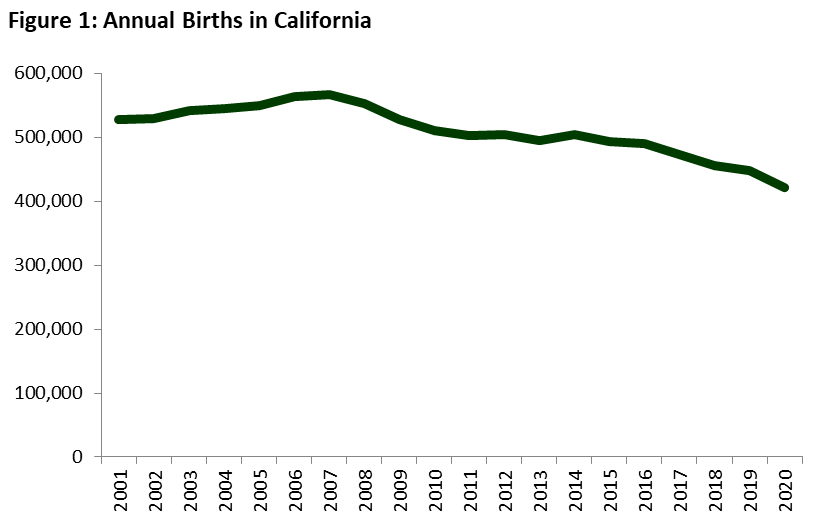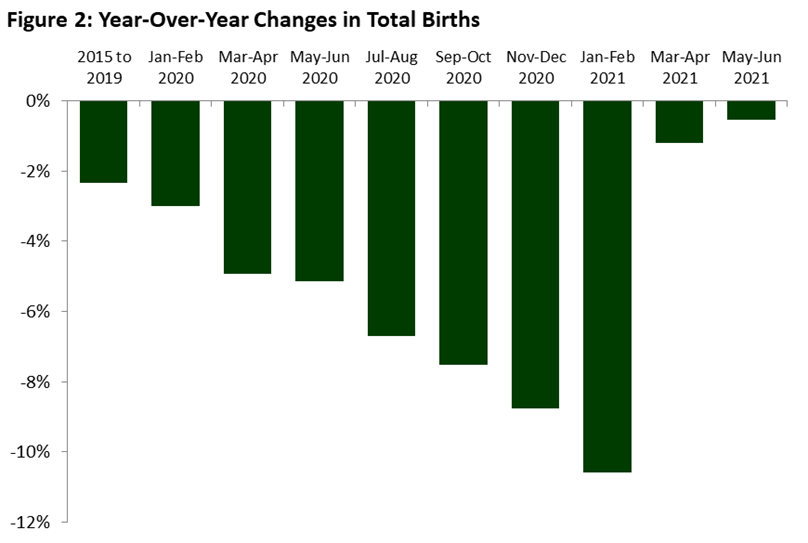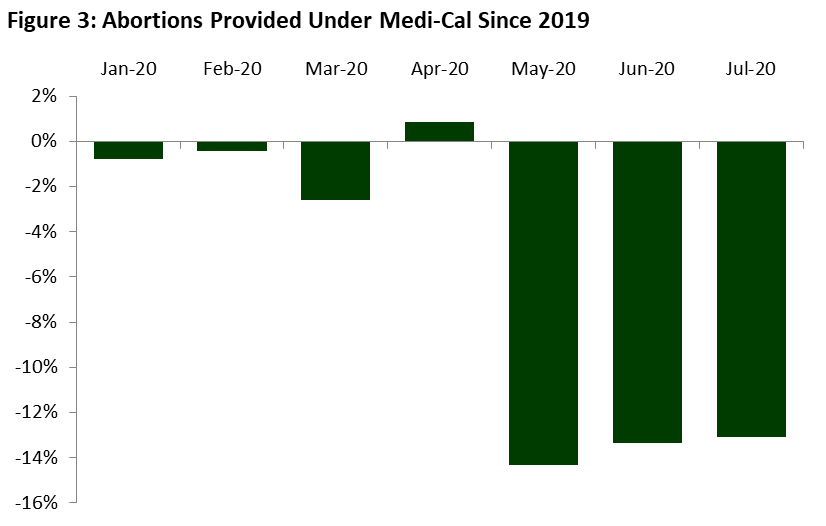Fewer Births in California Every Year Since 2015. Figure 1 below displays the annual number of babies born in California from 2001 through 2020. (The raw data are publicly available here.) Patterns during this period include:
- Growth in the early 2000s.
- A decline during and immediately after the Great Recession.
- Stagnation in the first half of the 2010s.
- Declines in every year from 2015 to 2020.
Decline Accelerated in 2020. In 2020, 6% fewer babies were born in California than in 2019—the biggest one-year drop since 1972. In the rest of this post, we take a closer look at what happened to births in 2020 and in the first half of 2021.
Why Would Births Drop Faster In 2020? The large drop in births from 2019 to 2020 could have occurred for a variety of reasons. Broadly, these potential explanations include:
- Effects of the COVID-19 Emergency on Conceptions? Prospective parents could have changed their plans due to job losses or other aspects of the COVID-19 crisis. Additionally, dramatic changes in social interaction could have reduced sexual activity and resulting births.
- Effects of the COVID-19 Emergency on Abortion Decisions? In much the same way that the onset of the crisis could have reduced planned conceptions, it could have increased abortions of existing pregnancies.
- Other Effects of the COVID-19 Emergency? For example, changes in the flow of adults into or out of California could have affected the total number of births in the state.
- Factors Entirely Unrelated to COVID-19? Suppose, for example, that birth declines over the last half-decade are due to gradual changes in various social and economic determinants of fertility. If so, perhaps those factors would have continued—or even accelerated—in 2020 even if the COVID-19 emergency had not occurred.
Births Reached Very Low Levels in Late 2020 and Early 2021... Figure 2 below displays year-over-year changes in births in each two-month period from January 2020 through June 2021. For example, the number for the first two months of 2020 is -3%, indicating that there were 3% fewer births in those months than in the first two months of 2019. The biggest declines shown in the Figure occurred in late 2020 and early 2021. The timing of these declines suggests that California’s COVID-19 emergency—which escalated in March 2020, 8 to 11 months earlier—might have reduced conceptions substantially, consistent with the first explanation listed above (effects of COVID-19 on conceptions). Both the year-over-year decline and the decline relative to the pre-pandemic baseline in 2019 were much smaller in March-June 2021 than in January-February 2021, suggesting that this effect could be transitory.
…But Large Birth Declines Started Much Earlier in 2020. If the year-over-year drop in births simply reflected a change in conceptions due to COVID-19, then large declines in the monthly birth numbers would not appear until November 2020. As shown in Figure 2, however, substantial declines already had occurred earlier in the year, suggesting that other factors explain a large part of the year-over-year drop.
Do Abortions Explain Early Fall Decline? At first glance, some of the pre-November birth declines—particularly the one in September-October—seem like they could reflect an increase in abortions, in line with the second explanation listed above (effects of COVID-19 on abortions). To investigate this possibility, we obtained monthly data on abortions provided under Medi-Cal. Ideally, we would have examined data on all abortions, but because such data are not yet available for 2020, we used Medi-Cal data as an indicator for possible broader trends. Medi-Cal covers roughly one-third of Californians, so we would not expect abortion trends in the overall population to be dramatically different from trends for Medi-Cal beneficiaries.
Abortions Provided Under Medi-Cal Did Not Increase in Early 2020. Figure 3 below displays year-over-year changes in the total number of abortions provided under Medi-Cal over the first seven months of 2020. Abortions provided under Medi-Cal did not increase substantially in March or April 2020. If abortions more broadly followed a similar pattern, then they likely did not contribute to the birth declines observed in late summer and early fall of 2020.
Sudden Drop in Abortions Provided Under Medi-Cal in May 2020. Figure 3 shows that abortions provided under Medi-Cal in May, June, and July 2020 were substantially lower than in 2019. Strikingly, this large decline occurred even though Medi-Cal caseloads were growing due to the economic crisis. The timing of this decline in abortions is consistent with a decline in conceptions starting in spring 2020—perhaps due, in part, to dramatic changes in social interaction during that time.
Conclusion: Likely Multiple Reasons for Birth Decline. The data presented above suggest that a drop in conceptions due to the COVID-19 emergency likely contributed substantially to the 2020 birth decline. This drop in conceptions likely stemmed from a combination of two factors: (1) choices to delay or forgo pregnancies; (2) reduced sexual activity due to dramatic changes in social interaction. That said, other factors—related or unrelated to COVID-19—also seem to have played a very important role. Although the COVID-19 emergency might have led to some abortions of existing pregnancies, this effect does not seem likely to explain a large part of the birth decline.
Why Total Births Rather Than Birth Rates? In this post, we have focused on total births in California, rather than birth rates. A birth rate is the number of births divided by the number of women within a specified age range. To our knowledge, reliable age-specific population estimates are not available at a monthly frequency, making a monthly birth rate analysis infeasible. Due to our focus on total births, potential explanations for the observed patterns include not just changes in fertility-related behavior, but also flows of adults into and out of California.



